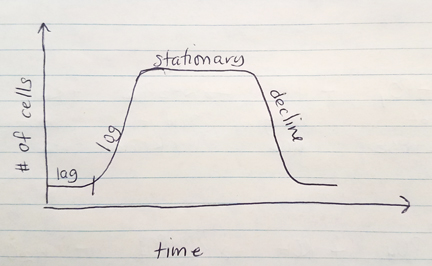The general bacterial growth curve has 4 phases: lag, logarithmic (log), stationary, and decline/death. You can remember this by “LLSD” (yea, like the illegal drug).
Lag phase. After an inoculation, the bacterial cells need time to acclimate to their new environment such as a petri dish with nutrient agar. It takes some time for the cells to adjust. Metabolism is in overdrive—especially the production of necessary enzymes. Cells increase in size, but not in numbers (no cell division yet).
Log phase. In favorable environmental condtions (e.g. abundance of nutrients), cells reproduce via binary fission at an uniform rate. The number of cells increase exponentially. The generation time is the time needed for the number of cells to double.
Stationary phase. Think of it like this: the number of births = the number of deaths. The number of cells undergoing binary fission = the number of cell deaths. Therefore, there is no appreciable increase in population size. The environmental nutrient levels may not support the population (nutrition getting depleted). There may be a build-up of metabolic by-products that could be toxic to the population. The “real estate” or space (e.g. petri dish size) may not support a population growth spurt.
Decline/Death phase. Usually this is due to limited and depletion of nutrients; build-up of toxins; and limited space. The decline “curve” is very close to the log phase curve.
Reference
Cappuccino, J. G., & Welsh, C. (2018). Microbiology: A laboratory manual.

